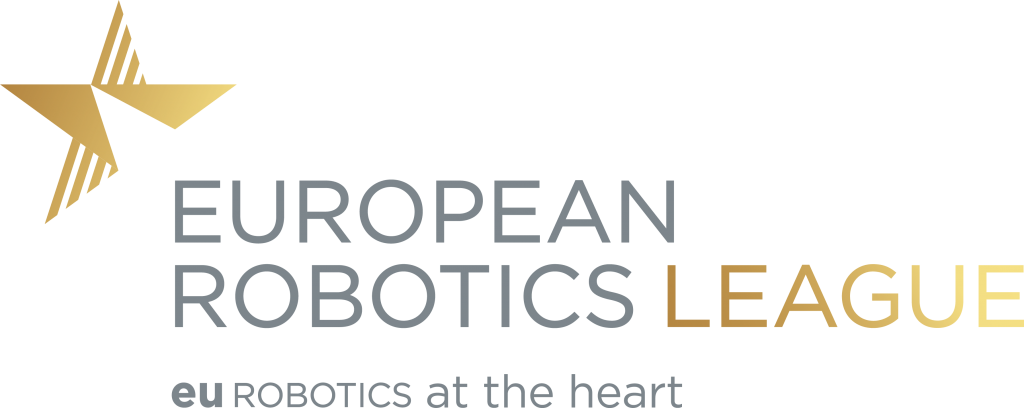
From November 25 to 28, 2024, the 1st euROBIN Coopetition will take place in Nancy, France, following Humanoids 2024, the IEEE-RAS 2024 International Conference on Humanoid Robots.
euROBIN coopetitions are designed not only to test individual team capabilities but also to foster collaborative innovation by rewarding teams for both their own achievements and the successful integration of their developed modules by others. By promoting modularity, reusability, and transferability in robotic systems, euROBIN aims to advance the frontier of robotics and artificial intelligence, driving progress in diverse application domains such as robotic manufacturing, personal robotics, and outdoor robotics for sustainable communities. Hereby, with these profiles we would like to welcome you to the pioneering world of the euROBIN project, where the brightest robotic teams from across Europe converge to participate in this groundbreaking event.

- NAME: ETH Zurich, Robotic Systems Lab
- TYPE: University
- LEADER CONTACT: Victor Klemm / Marco Huttere
- PRESS CONTACT: To be confirmed
- URL WEBSITE: www.rsl.ethz.ch
- TWITTER: https://x.com/leggedrobotics
- VIDEOS: youtube.com/leggedrobotics
- ROBOTS OR PRODUCT: Quadruped on wheels, active suspension vehicle for outdoor logistics.
- TECHNICAL DESCRIPTION OF THE ROBOT/PRODUCTS: To be confirmed.
- STAND IN HUMANOIDS 2024: ETH Zurich, Robotic Systems Lab, will have a booth in HUMANOIDS 2024, with its robots.

🤖 Robot Rollin' Justin - DLR - Participants in the euROBIN Competition - European Robotics Week 2024

From November 25 to 28, 2024, the 1st euROBIN Coopetition will take place in Nancy, France, following Humanoids 2024, the IEEE-RAS 2024 International Conference on Humanoid Robots.
euROBIN coopetitions are designed not only to test individual team capabilities but also to foster collaborative innovation by rewarding teams for both their own achievements and the successful integration of their developed modules by others. By promoting modularity, reusability, and transferability in robotic systems, euROBIN aims to advance the frontier of robotics and artificial intelligence, driving progress in diverse application domains such as robotic manufacturing, personal robotics, and outdoor robotics for sustainable communities. Hereby, with these profiles we would like to welcome you to the pioneering world of the euROBIN project, where the brightest robotic teams from across Europe converge to participate in this groundbreaking event.

The humanoid robot Rollin' Justin is a platform for research in service robotics. Areas of application for the system are, in particular, household work and assisting astronauts in space.
The robot was first presented to the public in 2008.
- NAME: DLR Institute of Robotics and Mechatronics (German Aerospace Center)
- TYPE: Research Institute
- LEADER CONTACT: Prof. Alin Albu-Schäffer;
This email address is being protected from spambots. You need JavaScript enabled to view it. - PRESS CONTACT: Lioba Suchenwirth;
This email address is being protected from spambots. You need JavaScript enabled to view it. - URL WEBSITE: www.dlr.de/rm
- TWITTER: DLR - English (@DLR_en) / X
- VIDEOS: DLR RM - YouTube
- ROBOTS OR PRODUCTS SHORT PRESENTATION: Rollin' Justin (dlr.de)
Rollin' Justin’s compliant light-weight arms and four-finger hands make it an ideal platform for research into sensitive, ambidextrous manipulation. The mobile base allows autonomous operation over a long range. Motion detection sensors and stereo cameras enable 3D reconstruction of the robot’s environment. Unstructured, variable and dynamic environments require the robot to act independently and without human support. On the other hand, the robot must be able to work safely with people. Its multiple actuated degrees of freedom allow Rollin' Justin to pursue several goals at the same time while complying with a task hierarchy. For example, the robot can serve beverages while observing the environment, moving without singularity, avoiding collisions, compliantly responding to collisions with the environment – all without spilling the drinks.
- TECHNICAL DESCRIPTION OF THE ROBOT/PRODUCTS: Rollin' Justin (dlr.de)
Introducing our state-of-the-art humanoid robot, engineered to advance robotics technology significantly. The robot stands at 1.91 meters, the average height of an adult human, and has a weight of approximately 200 kilograms, offering a robust and substantial presence.
This robot features an impressive 51 degrees of freedom: 8 in the platform, 7 in each arm, 12 in each hand, 2 in the neck, and 3 in the torso, providing exceptional flexibility and maneuverability. It is capable of carrying up to 20 kilograms, making it suitable for various applications. The robot is powered by a battery that offers an operating time exceeding 60 minutes, ensuring reliable and sustained performance.
Capable of moving at a speed of 2 meters per second or 7.2 kilometers per hour, the robot can efficiently cover ground. Its working space extends from the floor up to a height of 2.7 meters, allowing it to perform tasks at multiple levels.
The robot is equipped with advanced features such as torque sensors in nearly all joints, enhancing precision and control. It also includes two balance sensors (IMU), two stereo cameras, and five RGB-D cameras, which contribute to its superior navigation and interaction capabilities. The compliant, hierarchical whole-body control ensures smooth and coordinated movements, enhancing its operational efficiency.
Designed for semi-autonomy, this robot is suitable for both terrestrial and extraterrestrial applications, providing versatility in various environments. With its advanced technical capabilities and innovative design, our humanoid robot represents a significant step forward in robotics technology.

- STAND IN HUMANOIDS 2024: Yes


From November 25 to 28, 2024, the 1st euROBIN Coopetition will take place in Nancy, France, following Humanoids 2024, the IEEE-RAS 2024 International Conference on Humanoid Robots.
euROBIN coopetitions are designed not only to test individual team capabilities but also to foster collaborative innovation by rewarding teams for both their own achievements and the successful integration of their developed modules by others. By promoting modularity, reusability, and transferability in robotic systems, euROBIN aims to advance the frontier of robotics and artificial intelligence, driving progress in diverse application domains such as robotic manufacturing, personal robotics, and outdoor robotics for sustainable communities. Hereby, with these profiles we would like to welcome you to the pioneering world of the euROBIN project, where the brightest robotic teams from across Europe converge to participate in this groundbreaking event.

The bimanual humanoid robot Tiago++ (Tiago dual) has omnidirectional handling for mobile manipulation, combining perception, navigation, manipulation and human-robot interaction. It belongs to the TIAGo family of mobile handling robots.
The robot was first presented to the public in November 2021.
- NAME: Inria
- TYPE: National Institute for Research in Digital Science and Technology
- LEADER CONTACT: Serena Ivaldi -
This email address is being protected from spambots. You need JavaScript enabled to view it. - PRESS CONTACT:
This email address is being protected from spambots. You need JavaScript enabled to view it. - URL WEBSITE: https://inria.fr/fr // https://inria.fr/en
- TWITTER: https://x.com/Inria
- LINKEDIN: https://www.linkedin.com/company/inria
- VIDEOS:
- ROBOTS OR PRODUCTS SHORT PRESENTATION: Tiago ++
The robot, produced by PAL Robotics, TIAGO++ has the ability to perform bimanual experiments with various types of grasping, thanks to the different types of end effectors available and provides flexibility that allows you to go further in any area of research.
It is capable of moving very easily, with versatility in navigation, for precision positioning even in complex environments, allowing researchers more possibilities than ever.
It is a built version of TIAGo, a popular mobile manipulator and the platform of choice for many institutions, as well as being used in robotics competitions.
- TECHNICAL DESCRIPTION OF THE ROBOT/PRODUCTS: Tiago ++
- They remove the original head.
- Added Orbbec RGB-D camera on both wrists and head (https://www.orbbec.com/products/tof-camera/femto-bolt/).
The omnidirectional drive allows TIAGo OMNI++ to move in all directions and the robot is ready for bimanual experiments and various types of grasping, thanks to the different types of end effectors available. Together, it provides flexibility that allows you to do more in any area of your research.
TIAGo OMNI++ is equipped with an omnidirectional drive system with 3 degrees of freedom mechanical wheels. These wheels give the robot 360 degrees of movement and more flexibility. It is a bimanual platform that includes interchangeable end effectors, a 360-degree LiDAR, and a display. The goal was to create a platform that was easily configurable and capable of addressing any robotics research need. The torso display is designed to further aid human robot research (HRI). The robot has two 7 DoF movable manipulator arms for manipulation tasks and a number of end-effector options, including a humanoid hand or various types of grippers; For now, they are the PAL Robotics Five Finger Hand, the PAL Robotics Parallel Gripper, the Robotiq 2F-140 and 2F-85 Grippers, and the Robotiq EPick Vacuum Gripper. The TIAGo OMNI++ mobile base includes two LIDAR sensors for safe movement with an unobstructed 360º field of view. This includes autonomous navigation, obstacle detection and route planning. The robot offers you the opportunity to take on new challenges and opens up the possibility of new use cases, with the aim of taking robotic research and mobile manipulation even further.

- STAND IN HUMANOIDS 2024: Yes

